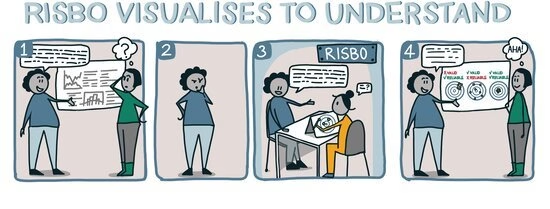“I always loved drawing, from an early age. My parents also liked drawing a lot, and I went to the Vrije School, so I was allowed to draw a lot there too. I always drew to make something beautiful, not to explain something. It wasn't until I started working at Risbo that I started using my drawing skills didactically as well.”
Emma de Goeje is educational consultant and trainer at Risbo. Part of her work is coordinating the UTQ, as well as acting as a trainer in and teaching of several MicroLabs, for example. Because of her graphic design skills, she is also part of Risbo's design team.
“It's not like I was hired on my design skills, not at all. However, the fact that I learned to put these to use during my educational consulting work is typical of Risbo: there is a lot of room to develop and to see how you can combine a private hobby with work.” For some of us this involves the field of design, for others it is about developing their own material, or being able to act as a training actor, for example.”
Can of Coke
While studying psychology, Emma became much more aware of the power of visuals. “Visualisation is so influential, and also helps you learn. I remembered certain concepts very well because of the imagery. While I really can't recall the texts themselves anymore! For example, I can still clearly recall the can of Coke that was used to explain the principle of reciprocity.”
"Images really support the story, and help convey a concept, an abstraction.”
Teaching observation
Emma regularly coaches teachers, for example by observing their teaching. “We still see a lot of powerpoint slides with a lot of text. Of course it's not forbidden to have text on your slide, but it has to be super well timed alongside your verbal story. However, the latter is often not done well, making the cognitive load on students far too heavy. Teachers sometimes say: yes, but my students want this, they need the slides with text to practice with! If you really want to facilitate this in that way, then please do it in two stages: only use slides with visuals during the lecture, which support your story, and only give a summary - textual - slide afterwards.”
Emma recently came across a very good example of how to use the power of visuals: She noticed it while observing a physics class: “Something complex was explained: it was about a magnetic field around an electric wire - a subject I know very little about. But because of the pictures the teacher used, I could imagine something. He could never have done that with words alone. In this way, images really support the story, and help convey a concept, an abstraction.”
Ugly drawing
“I notice that my style of drawing has changed over the years. I use less details, and I now know better that less is more. Details are nice, but you don't need them to understand something. Besides, they take time, and can also be distracting. What I also learned is how to use color and give it a meaning, like a code. I always did that intuitively, but now more consciously and focused, and that improves my work.
I greatly admire Willemien Brand, who I also trained with. She gives training in business drawing: demonstrating something with a quick drawing, which is immediately put to use. For me, this kind of purposeful drawing is really difficult, because I like beautiful drawings. But I know it's not bad to make an ugly drawing, as long as it is effective.”
Abstractions
Emma emphasizes how important it is in educational drawing to first master the concept you want to convey. “You have to know very well exactly what point you want to make. Whilst verbally, you can go in any direction, graphically you have to be much precise, otherwise your visualisation won't work. I think that's cool.” She enjoys assignments that are initially very "dry", like an inaugural speech: “That is often very abstract stuff, but it needs to be told to a lay audience. First I have an extensive conversation with the client, looking for a metaphor that is appealing. After all, I can't draw anything without a metaphor! That process of searching for the best way to help people understand, is great fun.”
This is a cow
“Reading to my two children (1 and 3) has made me aware again of how we learn to learn: based on images. This is a picture of a cow, and this is how a cow sounds. We use pictures all the time to understand things, from an early age. So why do we apply this principle so little in university teaching?
What sets Risbo's design team apart from others is that we understand education. We really look at how pictures add value to the learning process of students. We are able to do that because we know what good education is, and what it entails. That combination of educational understanding and graphic talent, is just really strong, and quite unique”
"I think Risbo's combination of educational understanding and graphic talent is very strong ánd quite unique."
- More information
Want to know more about Risbo's design team and what they can do for you? Then take a look at the special web page we have set up for that purpose.
- Related links
- Read this glowing review of Emma's work

